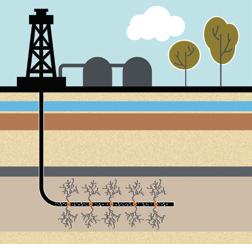
7 minute read
The Texas Oil Industry Needs Some Long-Term Thinking
By: David Blackmon
(Editor’s Note: As we went about putting this issue of SHALE Magazine together, the Texas Railroad Commission had just finished a month-long process during which it considered and rejected proposals to limit production in Texas through its power of prorationing. Because it became such a controversial issue, I felt it was important to have several viewpoints represented in this issue. Elsewhere you will find a piece opposing prorationing by Karr Ingham, the Executive Vice President of the Texas Alliance of Energy Producers. Karr is also a highly-regarded petroleum economist, and I felt he put forth an extremely well-informed position paper on this matter. You will also find a piece submitted by the folks at the Environmental Defense Fund (EDF), suggesting that the RRC use the power of prorationing to address the lingering issue of flaring huge volumes of natural gas in the Permian Basin. I felt it was also important for our readers to understand that argument, which I believe is well-reasoned. Finally, below is my own opinion on the subject, urging the Commission to take a more long-term view of prorationing, something that did not happen during April and May. My view is informed by 40 years in the industry, during which time I personally witnessed the damage caused by four major industry busts. Most of my career was spent doing public policy works, which also helps to inform my view on this issue.)
Advertisement
At its hearing on May 5, the Texas Railroad Commission (RRC) voted to end its month-long consideration of proposals to move to temporarily limit oil production in Texas using its power of proration. The formal action came after Commissioner Ryan Sitton decided on May 4 to withdraw a proposed order that would have limited each operator’s production to no more than 80% of its October 2019 volumes.
Thus, a bit of RRC history came to an end in which the commissioners ultimately decided to take no action and let the market take its course. In defense of the commissioners, no action is exactly what most industry stakeholders and all of the oil and gas state trade associations recommended. That, plus the fact that letting the market take its course is generally the Republican thing to do ended up carrying the day.
To be perfectly honest, I agreed with that “no action” decision, but only because the only approaches the commissioners considered were short term proposals that would have ended within a few months. However, I do believe that there is every reason for the RRC to seriously consider invoking its power to limit Texas oil production under a long-term plan, and to work with its fellow regulators in other states to do the same, for the industry’s own good.
The power to prorate production would not exist on the books today unless there were merits to using it in certain situations and/or emergencies. History demonstrates that, while it admittedly was a long time ago (most recently 1973), past Railroad Commissions have used this authority to the benefit of the interests of Texas, and used it over long periods of time.
The short-term proposals considered recently by the RRC had very likely already been rendered moot by rapidly-evolving market events. A 20% reduction from last October’s production levels applied in June or July would most likely have had no impact at all on most producers in the state.
On the other hand, a longer-term approach to this subject might have more merit and, in my view, would likely serve to help smooth out the industry’s boom and bust cycles that seem to become more radical and impactful over time. These cycles damage the industry’s reputation, OPEC often decimates its workforce and alienate many thousands of younger people from even considering a career in oil and gas. Plus, in this current crisis, leaving the U.S. industry dependent upon the willingness of other countries to surrender market share also alienates many potential investors and lenders.
These impacts have long and lasting effects. The industry has only recently finished going through what many have called its “great shift change,” as baby boomers, age 60 and over, have by and large now retired, leaving the workforce mostly in the hands now of employees who are age 50 and under.
That 10-year age gap stems from the dead zone decade that lasted from the mid-1980s through the mid-1990s, years following the great oil bust that began in 1984. That deep collapse in oil prices — caused by a massive supply surplus intentionally created by Saudi Arabia and — had the same sort of fallout in the industry we are seeing today.
As a result of all the layoffs, bankruptcies and general industry carnage that took place during 1984-1987, almost no teenagers coming out of high school chose to major in industry-related disciplines like petroleum engineering, geo-sciences and others for years thereafter. At the same time, few college graduates in other disciplines would even contemplate seeking careers in such an unreliable industry. The net result of that bust, and another, less-severe bust that followed a few years later, was a decade in which the industry had a painfully difficult time attracting talent.
I have written many times in the past about the fact that, in the United States, state regulatory bodies like the RRC possess the only means of trying to police an industry made up of thousands of competitors who cannot, by law, police themselves in an effort to limit production. The country’s antitrust laws are very clear and unforgiving on that subject.
Boom cycles, like the one we have seen in the past few years in the Permian Basin, invariably evolve into drilling free-for-alls in which production volumes rocket-up rapidly, eventually over-supply the market, and, unless the OPEC countries and Russia agree to limit their own production, cause the price to crash. Two years ago, shortly after the OPEC+ deal was put into place, I discussed the potential for the exact scenario we have seen play out in real-time over the last six weeks.
But now the OPEC+ deal is back in place again, this time with even deeper production cuts promised by those same countries who blew
up the prior OPEC+ deal and flooded the market in March. And, once supply and demand have come back into balance later this year, we will see the U.S. industry proceed to yet again start drilling itself into the next price crash.
Because, no matter what Saudi Arabia, Russia and the rest of the OPEC+ countries are telling us today, that deal is destined to eventually fall apart as well. After all, those countries are only going to be willing to surrender a certain amount of market share to the U.S. shale industry before their members once again tire of being asked to cut more of their own production.
This is not speculation — this is a simple inevitability unless regulators in states like Texas, North Dakota, Oklahoma, New Mexico and Wyoming decide to use their existing authorities to protect the upstream sector of the business from its own worst impulses. A coordinated plan designed to limit overall U.S. oil production to no more than a specific share of the global market could help to prevent or at least smooth out future boom and bust cycles.
Such coordinated efforts between the states are far from unprecedented. In fact, devising and implementing such coordinated plans is the precise reason why the Interstate Oil and Gas Compact Commission (IOGCC), an association of state oil and gas regulators, exists. The chairman of the Texas Railroad Commission is always the governor’s official representative to this organization. But if anyone in the regulatory community is having such long-term thoughts, it is not publicly apparent. Certainly, this longer-term view was not reflected in the proposed order the RRC momentarily considered. Nor has such a long-term approach been discussed around similar proposals that regulators in Oklahoma and North Dakota have considered in recent weeks. No one wants to think in these terms in part because doing so would be controversial and present public officials with great political risk. And in their defense, few if any of these regulatory agencies are currently staffed to perform the constant monitoring of and reaction to global market conditions that such a long-term approach would require.
That having been said, times change, market conditions change, emergencies like the current one arise, and these regulators have an obligation to sometimes make hard choices in the best interests of their respective states that may not be popular, either with the public or with the industry they regulate. Given the industry’s enormous contributions to the budgets of the states and local communities, isn’t it clearly in the best interests of these states and others to do what they can to ensure that industry is a more stable and reliable contributor during good times and bad?
Sure seems that way to me.
About the author: David Blackmon is the Editor of SHALE Oil & Gas Business Magazine. He previously spent 37 years in the oil and natural gas industry in a variety of roles — the last 22 years engaging in public policy issues at the state and national levels. Contact David Blackmon at editor@shalemag.com.










